Leopold II of Belgium
| Leopold II | |||||
|---|---|---|---|---|---|
 | |||||
| King of the Belgians | |||||
| Reign | 17 December 1865 – 17 December 1909 | ||||
| Predecessor | Leopold I | ||||
| Successor | Albert I | ||||
| Prime Ministers | |||||
| Sovereign of the Congo Free State | |||||
| Reign | 1 July 1885 – 15 November 1908 | ||||
| Born |
9 April 1835 Brussels, Belgium | ||||
| Died |
17 December 1909 (aged 74) Laeken, Belgium | ||||
| Burial | Church of Our Lady of Laeken | ||||
| Spouse |
Archduchess Marie Henriette of Austria (m. 1853 - 1902; her death) | ||||
| Issue |
Louise, Princess Philipp of Saxe-Coburg and Gotha Prince Leopold, Duke of Brabant Stéphanie, Crown Princess of Austria Clémentine, Princess Napoléon | ||||
| |||||
| House | Saxe-Coburg and Gotha | ||||
| Father | Leopold I of Belgium | ||||
| Mother | Louise of Orléans | ||||
Leopold II (9 April 1835 – 17 December 1909) reigned as the second King of the Belgians from 1865 to 1909. He became known for the founding and exploitation of the Congo Free State as a private venture. Born in Brussels as the second (but eldest surviving) son of Leopold I and Louise of Orléans, he succeeded his father to the Belgian throne in 1865 and reigned for 44 years until his death - the longest reign of any Belgian monarch. He died without surviving male issue; the current Belgian king descends from his nephew and successor, Albert I.
Leopold became the founder and sole owner of the Congo Free State, a private project undertaken on his own behalf. He used explorer Henry Morton Stanley to help him lay claim to the Congo, the present-day Democratic Republic of the Congo. At the Berlin Conference of 1884–1885 the colonial nations of Europe authorized his claim by committing the Congo Free State to improving the lives of the native inhabitants. From the beginning, however, Leopold essentially ignored these conditions. He ran the Congo using the mercenary Force Publique for his personal enrichment. He used great sums of the money from this exploitation for public and private construction projects in Belgium during this period. He donated the private buildings to the state before his death, to preserve them for Belgium.
Leopold extracted a fortune from the Congo, initially by the collection of ivory, and - after a rise in the price of rubber in the 1890s - by forced labour from the natives to harvest and process rubber. Under his régime millions of the Congolese people died; modern estimates range from 1 to 15 million, with a consensus growing around 10 million. Human-rights abuses under his régime contributed significantly to these deaths. Reports of deaths and abuse led to a major international scandal in the early 20th century, and the Belgian government ultimately forced Leopold to relinquish control of the colony to Belgian civil administration in 1908.
Early life

Leopold was born in Brussels on 9 April 1835. He was the second child of the reigning Belgian monarch, Leopold I, and his second wife, Louise, the daughter of King Louis Philippe of France. The French Revolution of 1848, which spared Belgium, forced Louis Philippe to flee to the United Kingdom, of which Leopold's cousin Queen Victoria was monarch. The royal families of Belgium and the United Kingdom were linked by numerous marriages, and were additionally both descended from the House of Saxe-Coburg and Gotha. Louis Philippe died two years later, in 1850. Leopold's fragile mother was deeply affected by the death of her father, and her health deteriorated. She died that same year, when Leopold was 15 years old.
Marriage and family
Three years later, in 1853 at the age of 18, he married Marie Henriette of Austria in Brussels on August 22. Marie Henriette was a cousin of Emperor Franz Joseph I of Austria, and granddaughter of Leopold II, Holy Roman Emperor through her father, Austrian archduke Joseph. Marie Henriette was lively and energetic, and endeared herself to the people by her character and benevolence, and her beauty gained for her the sobriquet of "The Rose of Brabant".[1] She was also an accomplished artist and musician. She was passionate about horseback riding to the point that she would care for her horses personally. Some joked about this "marriage of a stableman and a nun",[2] the shy and withdrawn Leopold referred to as the nun.
Four children were born of this marriage, three daughters and one son, also named Leopold. The younger Leopold died in 1869 at the age of nine from pneumonia after falling into a pond. His death was a source of great sorrow for King Leopold, who lost his only heir. The marriage had become unhappy, and the couple separated completely after a last attempt to have another son, a union which resulted in the birth of their last daughter Clementine. In 1895 Marie Henriette retreated to Spa. She died there in 1902.[3]
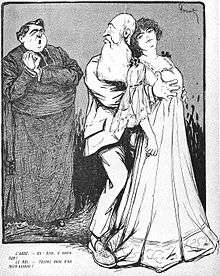
The Abbot: Oh! Sire, at your age?
The King: You should try it for yourself!
Leopold had many mistresses. In 1899 at age 65, Leopold took as a mistress Caroline Lacroix, a 16-year-old French prostitute, and they remained together for the next decade until his death. Leopold lavished upon her large sums of money, estates, gifts, and a noble title, Baroness Vaughan. Because of these gifts and the illegitimacy of their relationship, Caroline was deeply unpopular among the Belgian people and internationally. She and Leopold married secretly in a religious ceremony five days before his death; their failure to perform a civil ceremony rendered the marriage invalid under Belgian law. After the king's death, it was soon discovered that he had left Caroline a massive amount of wealth, which the Belgian government and Leopold's three estranged daughters tried to seize as rightfully theirs. Caroline bore two illegitimate sons who were likely Leopold's; the boys would have had a strong claim to the throne had the marriage been valid.
Early political career

As Leopold's older brother, also named Louis Philippe, had died the year before Leopold's birth, Leopold was heir to the throne from his birth. When he was 9 years old, Leopold received the title of Duke of Brabant, and was appointed a sub-lieutenant in the army. He served in the army until his accession in 1865, by which time he had reached the rank of lieutenant-general.[1]
Leopold's public career began on his attaining the age of majority in 1855, when he became a member of the Belgian Senate. He took an active interest in the senate, especially in matters concerning the development of Belgium and its trade, and began to urge Belgium's acquisition of colonies. From 1854 to 1865, Leopold traveled extensively abroad, visiting India, China, Egypt, and the countries on the Mediterranean coast of Africa. Leopold's father died on December 10, 1865, and Leopold took the oath of office on December 17, at the age of 30.[3]
Domestic reign

In 1865 Leopold became king. Leopold explained his goal for his reign in an 1888 letter addressed to his brother, Prince Philippe, Count of Flanders: "the country must be strong, prosperous, therefore have colonies of her own, beautiful and calm."[4]
Leopold's reign was marked by a number of major political developments. The Liberals governed Belgium from 1857 to 1880 and during their final year in power, legislated the Frère-Orban Law of 1879. This law created free, secular, compulsory primary schools supported by the state and withdrew all state support from Roman Catholic primary schools. In 1880 the Catholic Party obtained a parliamentary majority and four years later restored state support to Catholic schools. In 1885 various socialist and social democratic groups drew together and formed the Labour Party. Increasing social unrest and the rise of the Labour Party forced the adoption of universal male suffrage in 1893.
During Leopold's reign other social changes were enacted into law. Among these were the right of workers to form labour unions and the abolition of the livret d'ouvrier, an employment record book. Laws against child labour were passed; children younger than 12 were not allowed to work in factories, children younger than 16 were not allowed to work at night, and women younger than 21 years old were not allowed to work underground. Workers gained the right to be compensated for workplace accidents, and were given Sundays off.
The first revision of the Belgian constitution came in 1893 under Leopold's reign. Universal male suffrage was introduced, though the effect of this was tempered by plural voting. The eligibility requirements for the senate were reduced, and elections would be based on a system of proportional representation, which continues to this day. Leopold pushed strongly to pass a royal referendum, whereby the king would have the power to consult the electorate directly on an issue, and use his veto according to the results of the referendum. The proposal was rejected, as it would have given the king the power to override the elected government; Leopold was so disappointed that he considered abdication.[5]
Leopold emphasized military defence as the basis of neutrality, and strove to make Belgium less vulnerable militarily. He achieved the construction of defensive fortresses at Liège, at Namur and at Antwerp. During the Franco-Prussian War, he managed to preserve Belgium's neutrality in a period of unusual difficulty and danger.[1] Leopold pushed for a reform in military service, but he was unable to obtain one until he was on his death bed. Under the old system of Remplacement, the Belgian army was a combination of volunteers and a lottery, and it was possible for men to pay for substitutes for service. This was replaced by a system in which one son in every family would have to serve in the military.
Builder King
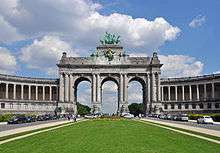
Leopold commissioned a great number of buildings, urban projects and public works, largely with the profits generated from exploitation of natural resources from the Congo. These projects earned him the epithet of "Builder King" (Koning-Bouwer in Dutch, le Roi-Bâtisseur in French). The public buildings were mainly in Brussels, Ostend and Antwerp, and include the Hippodrome Wellington racetrack, the Royal Galleries and Maria Hendrikapark in Ostend; the Royal Museum for Central Africa and its surrounding park in Tervuren; the Cinquantenaire park, triumphal arch and complex, and the Duden Park in Brussels, and the 1895-1905 Antwerpen-Centraal railway station.
In addition to his public works, he acquired and built numerous private properties for himself inside and outside Belgium. He expanded the grounds of the Royal Castle of Laeken, and built the Royal Greenhouses, the Japanese Tower and the Chinese Pavilion near the palace. In the Ardennes, his domains consisted of 6,700 hectares (17,000 acres) of forests and agricultural lands and the châteaux of Ardenne, Ciergnon, Fenffe, Villers-sur-Lesse and Ferage. He also built important country estates on the French Riviera, including the Villa des Cèdres and its botanical garden, and the Villa Leopolda.
Thinking of the future after his death, Leopold did not want the collection of estates, lands and heritage buildings he had privately amassed to be scattered amongst his daughters, each of whom was married to a foreign prince. In 1900, he created the Royal Trust, by means of which he donated most of his property to the Belgian nation. This preserved them to beautify Belgium in perpetuity, while still allowing future generations of the Belgian Royal family the privilege of their use.
Attempted assassination
On 15 November 1902, Italian anarchist Gennaro Rubino attempted to assassinate Leopold, who was riding in a royal cortege from a ceremony at Saint-Gudule Cathedrale in memory of his recently deceased wife, Marie Henriette. After Leopold's carriage passed, Rubino fired three shots at the procession; the shots missed Leopold but almost killed the king's Grand Marshall, Count Charles John d'Oultremont. Rubino was immediately arrested and subsequently sentenced to life imprisonment. He died in prison in 1918.
The king replied after the attack to a senator: Mon cher Senateur, si la fatalite veut que je sois atteint, tant pis![6] After the failed regicide the security of the king was questioned, because the glass of the landaus was 2 cm thick. Elsewhere in Europe, the news of this assassination attempt was received with alarm; other heads of state and the pope sent telegrams to the king congratulating him for surviving the assassination attempt. Many people remembered the earlier assassination of the Austrian Empress and the Italian king by another Italian anarchist.
The Belgians rejoiced that the king was safe. Later in the day, in the Theatre Royal de la Monnaie before Tristan und Isolde was performed, the orchestra played the Brabançonne, which was sung loudly and ended with loud cheers, acclamations, and applause.[6]
Congo Free State
Leopold was the founder and sole owner of the Congo Free State and all its people, a private project undertaken on his own behalf. He used explorer Henry Morton Stanley to help him lay claim to the Congo, an area now known as the Democratic Republic of the Congo. At the Berlin Conference of 1884–1885, the colonial nations of Europe authorized his claim by committing the Congo Free State to improving the lives of the native inhabitants. From the beginning, however, Leopold ignored these conditions and millions of Congolese inhabitants, including children, were mutilated and killed. He ran the Congo using the mercenary Force Publique for his personal enrichment.[7] He used great sums of the money from this exploitation for public and private construction projects in Belgium during this period. He donated the private buildings to the state before his death.
Leopold extracted a fortune from the Congo, initially by the collection of ivory, and after a rise in the price of rubber in the 1890s, by forced labour from the natives to harvest and process rubber. Under his regime millions of Congolese people died; modern estimates range from 1 million to 15 million, with a consensus growing around 10 million. Human rights abuses under his regime contributed significantly to these deaths. Reports of deaths and abuse led to a major international scandal in the early 20th century, and Leopold was ultimately forced by the Belgian government to relinquish control of the colony to the civil administration in 1908.
Obtaining the Congo Free State

Leopold fervently believed that overseas colonies were the key to a country's greatness, and he worked tirelessly to acquire colonial territory for Belgium. Leopold eventually began to acquire a colony as a private citizen. The Belgian government lent him money for this venture.
In 1866, Leopold instructed the Belgian ambassador in Madrid to speak to Queen Isabella II of Spain about ceding the Philippines to Belgium. However, knowing the situation fully, the ambassador did nothing. Leopold quickly replaced the ambassador with a more sympathetic individual to carry out his plan.[8] In 1868, when Isabella II was deposed as queen of Spain, Leopold tried to press his original plan to acquire the Philippines. But without funds, he was unsuccessful. Leopold then devised another unsuccessful plan to establish the Philippines as an independent state, which could then be ruled by a Belgian. When both of these plans failed, Leopold shifted his aspirations of colonization to Africa.[8]
After numerous unsuccessful schemes to acquire colonies in Africa and Asia, in 1876 Leopold organized a private holding company disguised as an international scientific and philanthropic association, which he called the International African Society, or the International Association for the Exploration and Civilization of the Congo. In 1878, under the auspices of the holding company, he hired the famous explorer Henry Stanley to explore and establish a colony in the Congo region.[9] Much diplomatic maneuvering among European nations resulted in the Berlin Conference of 1884–1885 regarding African affairs, at which representatives of 14 European countries and the United States recognized Leopold as sovereign of most of the area to which he and Stanley had laid claim.[10] On 5 February 1885, the Congo Free State, an area 76 times larger than Belgium, was established under Leopold II's personal rule and private army, the Force Publique.[11]
The Lado Enclave
In 1894, King Leopold signed a treaty with Great Britain which conceded a strip of land on the Congo Free State's eastern border in exchange for the Lado Enclave, which provided access to the navigable Nile and extended the Free State's sphere of influence northwards into Sudan.[12] After rubber profits soared in 1895, Leopold ordered the organization of an expedition into the Lado Enclave, which had been overrun by Mahdist rebels since the outbreak of the Mahdist War in 1881. The expedition was composed of two columns: the first, under Belgian war hero Baron Dhanis, consisted of a sizable force, numbering around three-thousand, and was to strike north through the jungle and attack the rebels at their base at Rejaf. The second, a much smaller force of only eight-hundred, was led by Louis-Napoléon Chaltin and took the main road towards Rejaf. Both expeditions set out in December 1896.[13]
Although Leopold had initially planned for the expedition to carry on much farther than the Lado Enclave, hoping indeed to take Fashoda and then Khartoum,[14] Dhanis' column mutinied in February 1897, resulting in the death of several Belgian officers and the loss of his entire force. Nonetheless, Chaltin continued his advance, and on 17 February 1897, his outnumbered forces defeated the rebels in the Battle of Rejaf, securing the Lado Enclave as a Belgian territory until Leopold's death in 1909.[15]
Exploitation, atrocities, and death toll
.jpg)
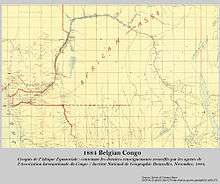
Leopold amassed a huge personal fortune by exploiting the natural resources of the Congo. At first, ivory was exported, but this did not yield the expected levels of revenue. When the global demand for rubber exploded, attention shifted to the labor-intensive collection of sap from rubber plants. Abandoning the promises of the Berlin Conference in the late 1890s, the Free State government restricted foreign access and extorted forced labor from the natives. Abuses, especially in the rubber industry, included the forced labor of the native population, beatings, widespread killing, and frequent mutilation when the production quotas were not met.[16] Missionary John Harris of Baringa was so shocked by what he had come across that he wrote to Leopold's chief agent in the Congo, saying:
"I have just returned from a journey inland to the village of Insongo Mboyo. The abject misery and utter abandon is positively indescribable. I was so moved, Your Excellency, by the people's stories that I took the liberty of promising them that in future you will only kill them for crimes they commit."[17]
Estimates of the death toll range from 1 million to 15 million,[18][19][20] since accurate records were not kept. Historians Louis and Stengers in 1968 stated that population figures at the start of Leopold's control are only "wild guesses", and that attempts by E. D. Morel and others to determine a figure for the loss of population were "but figments of the imagination".[21][22]
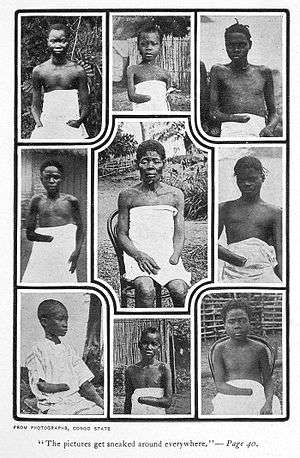
Adam Hochschild devotes a chapter of his book King Leopold's Ghost to the problem of estimating the death toll. He cites several recent lines of investigation, by anthropologist Jan Vansina and others, that examine local sources (police records, religious records, oral traditions, genealogies, personal diaries, and "many others"), which generally agree with the assessment of the 1919 Belgian government commission: roughly half the population perished during the Free State period. Hochshild points out that since the first official census by the Belgian authorities in 1924 put the population at about 10 million, these various approaches suggest a rough estimate of a total of 10 million dead.[23]
Smallpox epidemics and sleeping sickness also devastated the disrupted population.[24] By 1896, African trypanosomiasis had killed up to 5,000 Africans in the village of Lukolela on the Congo River. The mortality statistics were collected through the efforts of British consul Roger Casement, who found, for example, only 600 survivors of the disease in Lukolela in 1903.[25]
Criticism of the management of Congo

Inspired by works such as Joseph Conrad’s Heart of Darkness (1902), originally published as a three-part series in Blackwood’s Magazine (1899) and based on Conrad's experience as a steamer captain on the Congo 12 years earlier, international criticism of Leopold’s rule increased and mobilized. Reports of outrageous exploitation and widespread human rights abuses led the British Crown to appoint their consul Roger Casement to investigate conditions there. His extensive travels and interviews in the region resulted in the Casement Report, which detailed the extensive abuses under Leopold's regime.[26] A widespread war of words ensued. In Britain, former shipping clerk E. D. Morel with Casement's support founded the Congo Reform Association, the first mass human rights movement.[17] Supporters included American writer Mark Twain, whose stinging political satire entitled King Leopold's Soliloquy portrays the king arguing that bringing Christianity to the country outweighs a little starvation, and uses many of Leopold's own words against him.[27]
Writer Arthur Conan Doyle also criticised the "rubber regime" in his 1908 work The Crime of the Congo, written to aid the work of the Congo Reform Association. Doyle contrasted Leopold's rule to the British rule of Nigeria, arguing that decency required those who ruled primitive peoples to be concerned first with their uplift, not how much could be extracted from them. As Hochschild describes in King Leopold's Ghost, many of Leopold's policies, in particular those of colonial monopolies and forced labour, were influenced by Dutch practice in the East Indies.[28] Similar methods of forced labour were employed to some degree by Germany, France, and Portugal where natural rubber occurred in their own colonies.[29]
Relinquishment of the Congo
International opposition and criticism from both the Catholic Party and the Labour Party caused the Belgian parliament to compel the king to cede the Congo Free State to Belgium in 1908. The deal that led to the handover cost Belgium the considerable sum of 215.5 million Francs. This was used to discharge the debt of the Congo Free state and to pay out its bond holders as well as 45.5 million for Leopold's pet building projects in Belgium and a personal payment of 50 million to him.[30] The Congo Free State was transformed into a Belgian colony known as the Belgian Congo under parliamentary control. Leopold went to great lengths to conceal potential evidence of wrongdoing during his time as ruler of his private colony. The entire archive of the Congo Free State was burned and he told his aide that even though the Congo had been taken from him, 'they have no right to know what I did there.'[31]
After gaining its independence in the mid-20th century, it was renamed three times: first, as the Republic of the Congo; second as Zaire, the name it retained under Mobutu Sese Seko's dictatorship; and third as the Democratic Republic of the Congo, or DRC. (This is not to be confused with the neighboring Republic of the Congo, which was formerly a colony of France.)
Death and legacy

On 17 December 1909, Leopold II died at Laeken, and the Belgian crown passed to Albert, the son of Leopold's brother, Philip, Count of Flanders. His funeral cortege was booed by the crowd.[32] Leopold's reign of exactly 44 years remains the longest in Belgian history. He was interred in the royal vault at the Church of Our Lady of Laeken in Brussels.
After the king's death and transfer of his private colony to Belgium, there occurred a "Great Forgetting".[33] Many Belgians in the 20th and 21st centuries remember Leopold II as the "Builder King" for his extensive public works projects, and many remain unaware of his role in the atrocities in the Congo. In the 1990s, the colonial Royal Museum for Central Africa made no mention of the atrocities committed in the Congo Free State, despite the museum's large collection of colonial objects. On the boardwalk of Blankenberge, a popular coastal resort, a monument shows a pair of colonists as heroes protecting a desperate Congolese woman and child with "civilization".[34] In Ostend, the beach promenade has a 1931 sculptural monument to Leopold II, showing Leopold and grateful Ostend fishermen and Congolese. The inscription accompanying the Congolese group notes: "De dank der Congolezen aan Leopold II om hen te hebben bevrijd van de slavernij onder de Arabieren" ("The gratitude of the Congolese to Leopold II for having liberated them from slavery under the Arabs"). In 2004, an activist group cut off the hand of the leftmost Congolese bronze figure, in protest against the atrocities committed in the Congo. The city council decided to keep the statue in its new form, without the hand.[35][36]
Leopold II remains a controversial figure in the Democratic Republic of Congo. His statue in the capital Kinshasa was removed after independence. Congolese culture minister Christophe Muzungu decided to reinstate the statue in 2005. He noted that the beginning of the Free State had been a time of some economic and social progress. He argued that people should recognize some positive aspects of the king as well as the negative; but hours after the six-metre (20 ft) statue was installed near Kinshasa's central station, it was officially removed. The same workers took it down.[37]
Family

Leopold's sister became the Empress Carlota of Mexico. His first cousins included both Queen Victoria of the United Kingdom and her husband Prince Albert, as well as King Fernando II of Portugal.
He had four children with Queen Marie-Henriette, of whom the youngest two have descendants living as of 2014:
- Louise-Marie-Amélie, born in Brussels on 18 February 1858, and died at Wiesbaden on 1 March 1924. She married Prince Philipp of Saxe-Coburg and Gotha.
- Léopold Ferdinand Elie Victor Albert Marie, Count of Hainaut (as eldest son of the heir apparent), later Duke of Brabant (as heir apparent), born at Laeken on 12 June 1859, and died at Laeken on 22 January 1869, from pneumonia, after falling into a pond.
- Stéphanie Clotilde Louise Herminie Marie Charlotte, born at Laeken on 11 May 1864, and died at the Archabbey of Pannonhalma in Győr-Moson-Sopron, Hungary, on 23 August 1945. She married (1) Crown Prince Rudolf of Austria and then (2) Elemér Edmund Graf Lónyay de Nagy-Lónya et Vásáros-Namény (created, in 1917, Prince Lónyay de Nagy-Lónya et Vásáros-Namény).
- Clémentine, born at Laeken on 30 July 1872, and died at Nice on 8 March 1955. She married Prince Napoléon Victor Jérôme Frédéric Bonaparte (1862–1926), head of the Bonaparte family.
Leopold also fathered two illegitimate sons by Caroline Lacroix. They were adopted in 1910 by Lacroix's second husband, Antoine Durrieux.[38] Leopold granted them courtesy titles that were honorary, as the parliament would not have supported any official act or decree:
- Lucien Philippe Marie Antoine (9 February 1906 – 1984), duke of Tervuren[38]
- Philippe Henri Marie François (16 October 1907 – 21 August 1914), count of Ravenstein[38]
Titles, styles, arms and honours
Titles and styles
- 9 April 1835 – 16 December 1840: His Royal Highness Leopold, Crown Prince of Belgium, Prince of Saxe-Coburg and Gotha, Duke of Saxony
- 16 December 1840 – 17 December 1865: His Royal Highness The Duke of Brabant, Prince of Saxe-Coburg and Gotha, Duke of Saxony
- 17 December 1865 – 17 December 1909: His Majesty The King of the Belgians
- 1 July 1885 – 15 November 1908: His Serene Majesty Leopold II, King of the Belgians and Sovereign of the Congo Free State[39][40]
Honours

National Honours
9th April 1853: The Duke of Brabant was given the Grand Cordon of the Order of Leopold by his father as 18th birthday gift.[41]
.svg.png) Belgium
Belgium
- 17 December 1865 – 17 December 1909: Grand master of the Order of Leopold,
- 15 October 1897 – 17 December 1909: Grand master- Founder of the Order of the Crown
- 24 August 1900 – 17 December 1909: Grand master - founder of the Order of Leopold II
- 9 April 1891 – 17 December 1909: Grand master - founder of the Royal Order of the Lion
- 10 October 1908 – 17 December 1909: Grand master and founder of the Order of the African Star.
Foreign Honours
-
 Anhalt: Knight Grand Cross of the House Order of Albert the Bear
Anhalt: Knight Grand Cross of the House Order of Albert the Bear  Austrian Empire:
Austrian Empire:
- Knight of the Golden Fleece, by Emperor Franz Joseph in 1835.
- Knight grand Cross in the Imperial Order of Leopold.
- Knight grand Cross in the Royal Hungarian Order of Saint Stephen.
- Knight grand Cross in the Imperial Order of the Iron Crown.
-
 Cambodia: Knight Grand Cross of the Royal Order of Cambodia.
Cambodia: Knight Grand Cross of the Royal Order of Cambodia. -
.svg.png) Baden: Knight Grand Cross of the Order of the Zähringer Lion.
Baden: Knight Grand Cross of the Order of the Zähringer Lion. -
.svg.png) Two Sicilies: Knight Grand Cross of the Royal Order of the Two-Sicilies
Two Sicilies: Knight Grand Cross of the Royal Order of the Two-Sicilies -
.svg.png) Kingdom of Bavaria: Knight of the Royal Order of Saint Hubert.
Kingdom of Bavaria: Knight of the Royal Order of Saint Hubert. -
.svg.png) Empire of Brazil:
Empire of Brazil:
- Knight grand Cross in the National Order of the Southern Cross.
- Knight grand Cross in the Imperial Order of Dom Pedro I
-
.svg.png) Qing dynasty: Knight grand Cross in the Imperial Order of the Double Dragon .
Qing dynasty: Knight grand Cross in the Imperial Order of the Double Dragon . -
 Denmark: Knight of the Order of the Elephant.
Denmark: Knight of the Order of the Elephant. -
.svg.png) Ethiopian Empire: Knight grand Cross in the Order of the Seal of Solomon
Ethiopian Empire: Knight grand Cross in the Order of the Seal of Solomon -
 France: Knight grand Cross in the Legion of Honour.
France: Knight grand Cross in the Legion of Honour. -
.svg.png) Kingdom of Greece: Knight grand Cross in the Order of the Redeemer.
Kingdom of Greece: Knight grand Cross in the Order of the Redeemer. -
 Kingdom of Hanover: Knight of the Order of St. George.
Kingdom of Hanover: Knight of the Order of St. George. -
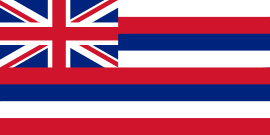 Kingdom of Hawaii: Knight grand Cross in the Royal Order of Kamehameha I
Kingdom of Hawaii: Knight grand Cross in the Royal Order of Kamehameha I -
 Grand Duchy of Hesse Hesse-Darmstadt:
Grand Duchy of Hesse Hesse-Darmstadt:
Knight grand Cross in the Ludwig Order. -
_crowned.svg.png) Kingdom of Italy: Knight grand Cross in the Supreme Order of the Most Holy Annunciation
Kingdom of Italy: Knight grand Cross in the Supreme Order of the Most Holy Annunciation -
 Japan:Knight grand Collar in the Supreme Order of the Chrysanthemum .
Japan:Knight grand Collar in the Supreme Order of the Chrysanthemum . -
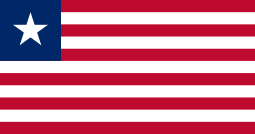 Liberia: Knight grand Cross in the Humane Order of African Redemption.
Liberia: Knight grand Cross in the Humane Order of African Redemption. - Knight grand Cross in the Order of Malta
-
 Mecklenburg-Schwerin:
Mecklenburg-Schwerin:
- Knight grand Cross in the House Order of the Wendish Crown.
- Knight grand Cross in the Order of the White Falcon.
- Knight grand Cross in the Order of the Eagle.
-
 Monaco : Knight grand Cross in the Order of Saint-Charles.
Monaco : Knight grand Cross in the Order of Saint-Charles. -
 Kingdom of the Netherlands:
Kingdom of the Netherlands:
Knight grand Cross in the Order of the Netherlands Lion. -
 Norway: Knight grand Cross in the Order of Saint Olav.
Norway: Knight grand Cross in the Order of Saint Olav. -
 Oldenburg: Knight grand Cross in the House and Merit Order of Peter Frederick Louis
Oldenburg: Knight grand Cross in the House and Merit Order of Peter Frederick Louis -
 Persia: Knight grand Cross in the Order of the Lion and the Sun.
Persia: Knight grand Cross in the Order of the Lion and the Sun. -
.svg.png) Kingdom of Portugal:
Kingdom of Portugal:
- Knight grand Cross in the Order of the Tower and Sword
- Knight grand Cross in the Military Order of Saint James of the Sword
- Knight grand Cross in the Military Order of Aviz
- Knight grand Cross in the Military Order of Christ.
-
.svg.png) Kingdom of Prussia:
Kingdom of Prussia:
- Knight grand Cross in the Order of the Black Eagle.
- Knight grand Cross in the Order of the Red Eagle.
- Knight grand Commander in the House Order of Hohenzollern.
-
 Kingdom of Romania: Knight grand Cross in the Order of Carol I.
Kingdom of Romania: Knight grand Cross in the Order of Carol I. .svg.png) Russian Empire:
Russian Empire:
- Knight grand Cross in the Order of St. Andrew the Apostle the First-Called.
- Knight grand Cross in the Order of Saint Anna.
-
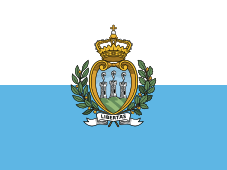 San Marino: Knight grand Cross in the Order of San Marino.
San Marino: Knight grand Cross in the Order of San Marino. -
 Saxony: Knight grand Cross in the Order of the Rue Crown.
Saxony: Knight grand Cross in the Order of the Rue Crown. -
.svg.png) Saxe-Coburg and Gotha: Knight grand Cross in the Saxe-Ernestine House Order.
Saxe-Coburg and Gotha: Knight grand Cross in the Saxe-Ernestine House Order. -
 Spain: Knight Grand Cross in the Order of Charles III.
Spain: Knight Grand Cross in the Order of Charles III. -
 Sweden: Knight of the Order of the Seraphim
Sweden: Knight of the Order of the Seraphim -
 Thailand: Knight grand Cross in the Order of the White Elephant
Thailand: Knight grand Cross in the Order of the White Elephant - Ordine del merito civile e militare (Toscana)
- House order of Osman: "Hanedan-i-Ali-Osman Nishani".
-
 Venezuela: Knight grand Cross in the Order of the Liberator.
Venezuela: Knight grand Cross in the Order of the Liberator. -
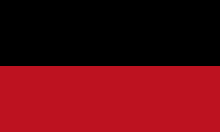 Kingdom of Württemberg: Knight grand Cross in the Order of the Crown.
Kingdom of Württemberg: Knight grand Cross in the Order of the Crown. -
 United Kingdom: Knight of the Most Noble Order of the Garter .
United Kingdom: Knight of the Most Noble Order of the Garter .
Arms
| Heraldry of Leopold II | |||||||||
|---|---|---|---|---|---|---|---|---|---|
|
Ancestry
Gallery
 Leopold II with the coat of arms of the Belgian Congo. Ghent, Belgium.
Leopold II with the coat of arms of the Belgian Congo. Ghent, Belgium..jpg) Bronze bust of Leopold II at the Royal Museum for Central Africa.
Bronze bust of Leopold II at the Royal Museum for Central Africa. Caricature of Leopold II. The caption reads: A constitutional king.
Caricature of Leopold II. The caption reads: A constitutional king. The last photo taken of Leopold II before his death.
The last photo taken of Leopold II before his death. Caroline LaCroix, Leopold's mistress.
Caroline LaCroix, Leopold's mistress.- Equestrian statue of Leopold II, Regent place, Brussels.
- Tomb of Leopold II and Marie Henriette.
 The Basilica of the Sacred Heart in Brussels, which Leopold II founded, seen from the boulevard named after him.
The Basilica of the Sacred Heart in Brussels, which Leopold II founded, seen from the boulevard named after him. A father stares at the hand and foot of his five-year-old daughter, severed as a punishment for having harvested too little rubber.
A father stares at the hand and foot of his five-year-old daughter, severed as a punishment for having harvested too little rubber. Krönungsmedaille Leopold II. – Thronbesteigung am 17 Dezember 1865 – von Léopold Wiener.
Krönungsmedaille Leopold II. – Thronbesteigung am 17 Dezember 1865 – von Léopold Wiener.
See also
- Abir Congo Company
- Émile Banning
- Congo Free State propaganda war
- Crown Council of Belgium
- Kings of Belgium family tree
References
- 1 2 3
 Chisholm, Hugh, ed. (1911). "Leopold II". Encyclopædia Britannica (11th ed.). Cambridge University Press.
Chisholm, Hugh, ed. (1911). "Leopold II". Encyclopædia Britannica (11th ed.). Cambridge University Press. - ↑ (in French) « mariage d'un palefrenier et d'une religieuse »
- 1 2 "Leopold II". The Belgian Monarchy. Retrieved December 4, 2013.
- ↑ (in French) « la patrie doit être forte, prospère, par conséquent posséder des débouchés à elle, belle et calme. » The King to the Count of Flanders, January 26, 1888; The Count of Flanders's papers.
- ↑ Stengers, Jean (2008). L'action du Roi en Belgique depuis 1831: pouvoir et influence [The action of the King in Belgium since 1831: power and influence] (in French) (3rd ed.). Brussels: Racine. pp. 123–4. ISBN 978-2-87386-567-2.
- 1 2 Meuse (La) 17-11-1902
- ↑ Ascherson (1999), p. 8.
- 1 2 Ocampo, Ambeth (2009). Looking Back. Anvil Publishing. pp. 54–57. ISBN 978-971-27-2336-0.
- ↑ Hochschild, Adam: King Leopold’s Ghost: A Story of Greed, Terror, and Heroism in Colonial Africa, Mariner Books, 1998. p. 62. ISBN 0-330-49233-0.
- ↑ Hochschild, A. 1999, King Leopold's Ghost - A Story of Greed, Terror and Heroism in Colonial Africa, London: Papermac, pp84-87
- ↑ Hochschild, A. 1999, King Leopold's Ghost - A Story of Greed, Terror and Heroism in Colonial Africa, London: Papermac, pp87&123-124
- ↑ Roger Louis, William (2006). Ends of British Imperialism. I.B.Tauris. ISBN 978-1-84511-347-6. p. 68.
- ↑ Charles de Kavanagh Boulger, Demetrius (1898).The Congo State: Or, The Growth of Civilisation in Central Africa. Congo: W. Thacker & Company. ISBN 0-217-57889-6. p. 214.
- ↑ Pakenham, Thomas (1992). The Scramble for Africa. Avon Books. ISBN 978-0-380-71999-0. p. 525-6.
- ↑ "Lado Enclave". Encyclopædia Britannica. Encyclopædia Britannica, inc. 19 July 2011.
- ↑ Neal Ascherson, The King Incorporated: Leopold the Second and the Congo (Granta Books, 1999)
- 1 2 Dummett, Mark (24 February 2004). "King Leopold's legacy of DR Congo violence". BBC. Retrieved 1 December 2011.
- ↑ Forbath, Peter (1977). The River Congo: The Discovery, Exploration and Exploitation of the World's Most Dramatic Rivers. Harper & Row. p. 278. ISBN 978-0-06-122490-4.
- ↑ Wertham, Fredric (1968). A Sign For Cain: An Exploration of Human Violence. ISBN 978-0-7091-0232-8.
- ↑ Hochschild, Adam (2006). King Leopold's Ghost: A Story of Greed, Terror, and Heroism in Colonial Africa. ISBN 978-1-74329-160-3.
- ↑ Louis, William Roger; Stengers, Jean (1968). E. D. Morel's History of the Congo Reform Movement. London: Clarendon. pp. 252–7. OCLC 685226763.
- ↑ Guy Vanthemsche (2012). Belgium and the Congo, 1885-1980. Cambridge University Press.
- ↑ Hochschild, Adam (2006). King Leopold's Ghost: A Story of Greed, Terror, and Heroism in Colonial Africa. pp. 225–33. ISBN 978-1-74329-160-3.
- ↑ "The 'Leopold II' concession system exported to French Congo with as example the Mpoko Company" (PDF). Archived from the original (PDF) on March 27, 2009. Retrieved 2011-12-02.
- ↑ "Le rapport Casement annoté par A. Schorochoff" (PDF). Posted at the website for the Royal Union for Overseas Colonies, http://www.urome.be.
- ↑ Ascherson, p. 250–260.
- ↑ "Time". 16 May 1955. Retrieved 7 May 2010.
- ↑ Hochschild, A. 1999, King Leopold's Ghost - A Story of Greed, Terror and Heroism in Colonial Africa, London: Papermac, p37
- ↑ Hochschild, p. 280.
- ↑ Hochschild, A. 1999, King Leopold's Ghost - A Story of Greed, Terror and Heroism in Colonial Africa, London: Papermac, p259
- ↑ Hochschild, A. 1999, King Leopold's Ghost - A Story of Greed, Terror and Heroism in Colonial Africa, London: Papermac, p294
- ↑ Dargis, Manohla (21 October 2005). "The Horrors of Belgium's Congo". www.nytimes.com. Retrieved 4 December 2016.
- ↑ Hochschild (1998), King Leopold's Ghost
- ↑ (in Dutch) Monument to De Bruyne and Lippens
- ↑ Pieter De Vos. "Sikitiko" (in Dutch). Retrieved 2012-08-13.
De dank der Congolezen aan Leopold II om hen te hebben bevrijd van de slavernij onder de Arabieren (1:10)
- ↑ "Leopold II krijgt zijn hand terug als Oostende zwicht" [Oostende herstelt afgehakte hand van Leopold II niet] (in Dutch). 2004-06-22. Archived from the original on 2014-01-01. Retrieved 2012-08-13.
- ↑ Vasagar, Jeevan (4 February 2005). "Leopold reigns for a day in Kinshasa". The Guardian.
- 1 2 3 "Le Petit Gotha"
- ↑ "George Washington Williams's Open Letter to King Leopold on the Congo". blackpast.org. 1890. Retrieved 12 January 2017.
- ↑ Hochschild, A. 1999, King Leopold's Ghost - A Story of Greed, Terror and Heroism in Colonial Africa, London: Papermac, pp. 87, 95, 102, 359
- ↑ Almanach royal officiel, publié, exécution d'un arrête du roi, Volume 1 ; Tarlier, 1854
Bibliography
- Ascherson, Neal: The King Incorporated, Allen & Unwin, 1963. ISBN 1-86207-290-6 (1999 Granta edition).
- Hochschild, Adam: King Leopold’s Ghost: A Story of Greed, Terror, and Heroism in Colonial Africa, Mariner Books, 1998. ISBN 0-330-49233-0.
- Petringa, Maria: Brazza, A Life for Africa, 2006. ISBN 978-1-4259-1198-0
- Wm. Roger Louis and Jean Stengers: E.D. Morel's History of the Congo Reform Movement, Clarendon Press Oxford, 1968.
- Ó Síocháin, Séamas and Michael O’Sullivan, eds: The Eyes of Another Race: Roger Casement's Congo Report and 1903 Diary. University College Dublin Press, 2004. ISBN 1-900621-99-1.
- Ó Síocháin, Séamas: Roger Casement: Imperialist, Rebel, Revolutionary. Dublin: Lilliput Press, 2008.
- Roes, Aldwin (2010). "Towards a History of Mass Violence in the Etat Indépendant du Congo, 1885–1908". South African Historical Journal. 62 (4): 634–70. doi:10.1080/02582473.2010.519937.
- Stanard, Matthew G. Selling the Congo: A history of European pro-empire propaganda and the making of Belgian imperialism (U of Nebraska Press, 2012)
External links
| Wikimedia Commons has media related to Leopold II of Belgium. |
| Wikiquote has quotations related to: Leopold II of Belgium |
- Official biography from the Belgian Royal Family website
- "The Political Economy of Power" Interview with political scientist Bruce Bueno de Mesquita, with a discussion of Leopold halfway through
- Interview with King Leopold II Publishers' Press, 1906
- Mass crimes against humanity in the Congo Free State
- Congo: White king, red rubber, black death A 2003 documentary by Peter Bate on Leopold II and the Congo
- The Crime of the Congo, 1909, Sir Arthur Conan Doyle, Archive.org
- Grant, Kevin (2001). "Christian critics of empire: Missionaries, lantern lectures, and the Congo reform campaign in Britain". The Journal of Imperial and Commonwealth History. 29 (2): 27–58. doi:10.1080/03086530108583118.
- Peffer, John (2008). "Snap of the Whip/Crossroads of Shame: Flogging, Photography, and the Representation of Atrocity in the Congo Reform Campaign". Visual Anthropology Review. 24: 55–77. doi:10.1111/j.1548-7458.2008.00005.x.
- van den Braembussche, Antoon (2002). "The Silence of Belgium: Taboo and Trauma in Belgian Memory". Yale French Studies (102): 34–52. JSTOR 3090591.
- Weisbord, Robert G. (2003). "The King, the Cardinal and the Pope: Leopold II's genocide in the Congo and the Vatican". Journal of Genocide Research. 5: 35–45. doi:10.1080/14623520305651.
- Langbein, John H. (January 1976). "The Historical Origins of the Sanction of Imprisonment for Serious Crime". The Journal of Legal Studies. 5 (1): 35–60. JSTOR 724073.
- Gewald, Jan-Bart (2006). "More than Red Rubber and Figures Alone: A Critical Appraisal of the Memory of the Congo Exhibition at the Royal Museum for Central Africa, Tervuren, Belgium". The International Journal of African Historical Studies. 39 (3): 471–86. JSTOR 40034827.
- Pavlakis, Dean (2010). "The Development of British Overseas Humanitarianism and the Congo Reform Campaign". Journal of Colonialism and Colonial History. 11 (1). doi:10.1353/cch.0.0102.
| Leopold II of Belgium Cadet branch of the House of Wettin Born: 9 April 1835 Died: 17 December 1909 | ||
| Regnal titles | ||
|---|---|---|
| Preceded by Leopold I |
King of the Belgians 1865–1909 |
Succeeded by Albert I |
| Belgian royalty | ||
| New title | Duke of Brabant 1840–1865 |
Succeeded by Leopold |
.svg.png)
.svg.png)

